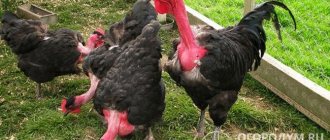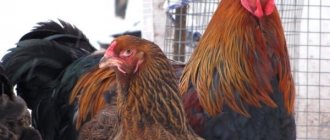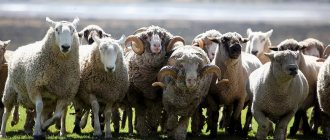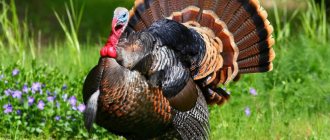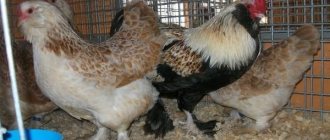Chicken is a delicious, nutritious meat that is popular in Russia and all over the world. In the past, raising chickens was a labor-intensive and costly endeavor, as it required a lot of time and money (for feed) to produce meat. Therefore, chicken used to be quite expensive, and people with good incomes could afford it.
However, much has changed since breeders developed broiler chickens, which are an interspecific hybrid of several chicken breeds. But why do we need broilers at all? What to feed them and what characteristics do they have? What breeds of broilers are there for industrial or home breeding? These issues will be discussed in the article.
Why do we need broilers?
Broilers are a hybrid breed of chicken that is often bred to produce chicken meat. Adults have white or reddish-white plumage and an average weight of 4-5 kilograms. Broiler birds have a large body, small legs and a small head. Broilers have a calm character, rarely get into fights and can eat any plant food, as well as mixed feed.
Broilers are a popular breed in industrial livestock farming because they have a number of advantages:
- Precocity. The chicken grows during the first 3-4 months after birth. Subsequently, its growth stops, so it can be sent for slaughter.
- A lot of meat. During 3-4 months of growth, a chicken gains 4-5 kilograms of weight, with most of the weight being meat (breast, legs and wings).
- Minimum feed consumption. The costs for chickens of this breed are minimal - 4-5 kg of combined feed. Chickens can eat this food already at 1-2 weeks of life.
- Easy to breed. Broilers do not require special rules and conditions of care, they are distinguished by their gentle nature, they can be bred on small compact farms.
Corniche
Cornish Cross broiler chickens and related hybrids are incredibly popular in the meat industry.
They are able to grow up to 5.5 kg in just 2.5-3 months. Because of this rapid growth rate, they are the most sought after broiler among industrial meat producers and among people who raise chickens for meat at home.
In addition, Cornish dogs grow many times faster than dual-purpose breeds. Also, they are tastier than the same dual-purpose breeds. Because these chickens grow so quickly, the broiler's activity level is very low, making the bird calm and docile.
The Cornish are distinguished by their broad chest and large hips. The bird's legs are bright yellow and very thick.
Weight (rooster) – 5.4 kg
Weight (chicken) – 3.6 kg
Growth period – 4-6 weeks
Advantages: very fast growth
How are broilers hatched?
Broilers are a hybrid variety of chickens that were bred by crossing several breed lines of meat and meat-egg production. The Cornish and White Plitmurok breeds were used to produce early broiler birds; Later, hybridization was also carried out with the breeds of New Hampshire, Brahma, Fighting Cornish and others. Today, broiler breeding is carried out on large farms for the needs of the food industry, as well as on small farms for private needs.
Breeding of broiler chickens is carried out according to the following algorithm:
- Hatching eggs. Like all regular chickens, broilers reproduce using eggs. A laying hen or an electronic incubator device is used for incubation. Hatching of eggs lasts 20-25 days, depending on temperature conditions and humidity in the room.
- Feeding. Upon completion of incubation, small chicks are born that can move and eat independently. Chickens do not need specific care, although at first you feed them natural food (on days 5-10 you can switch them to compound feed).
- Growing up, growing up, being sent to slaughter. Due to the characteristics of the breed, chickens quickly grow up and reach maturity. Over the course of 3-4 months of life, they gain weight of approximately 4-5 kilograms. At this age, chickens can be sent to slaughter, since they will not grow any further.
Attention! Broilers can be used to produce eggs. The average number of eggs per year for broilers is 140-160.
conclusions
- Now you know which breeds of broilers are best to grow at home. This activity is considered quite profitable and productive. Poultry produces meat in quantities exceeding the minimum cost of feed.
- If you have chosen the best breed that successfully combines endurance and early maturity, do not forget to provide young chickens with proper care and nutrition.
- Like other types of poultry, broilers are capable of laying eggs. But growing them for this purpose is not always profitable, because on average the yield of egg products is from 100 to 120 pieces per year.
- If you follow all the rules for raising poultry and the specifics of the breed, you can easily achieve rapid weight gain in chicks and provide yourself with a high-quality meat product in large quantities.
Advantages and disadvantages
Breeding broiler chickens has advantages and disadvantages. Let's look at the advantages first:
- Good yield of meat, ease of keeping and feeding birds of this breed.
- High survival rate (95-98%), chickens can be used to produce eggs.
- High-quality tasty meat that is suitable for preparing many dishes.
- Low feed costs, rapid growth of chickens (can be sent to slaughter at 3-4 months of age).
But let's not forget about the disadvantages:
- To hatch eggs, you need an incubator (in females the maternal instinct is dulled).
- Modest egg yield in comparison with other breeds (first clutch - after 7-8 months).
- If fed low-quality feed without minerals/vitamins, chickens often get sick and die.
- The room must have a stable temperature of +20 degrees for the birds to grow well.
Chickens "KOBB-500"
The rather large bird is very popular among farmers and poultry keepers. This is explained by the proportional accumulation of live weight with an almost ideal growth rate ratio. White and red meat are proportionally distributed in the carcass. The leather of the cross has a yellowish color, which the consumer really likes.
The positive characteristics of the KOBB-500 broiler include:
- high increase in live weight (in 40 days the bird gains about 2.5 kg);
- strong, large legs;
- excellent survival rates;
- large snow-white breast;
- low cost of meat;
- omnivorous bird.
To obtain the best productivity of the breed, it is necessary to monitor the conditions and quality of feed.
Peculiarities
Compared to other breeds of chickens, broilers have a number of features:
- Male broilers are larger in size than females. The weight of an adult male is 4-5 kg, while the female is 3-4 kg.
- To breed broilers, it is recommended to buy eggs from breeders. Breeding on your own can lead to degeneration of the breed (the amount of meat decreases and health deteriorates).
- You can feed broilers with plant foods or ready-made feed. The second option is more preferable, since the food contains the necessary vitamins and microelements.
- Chickens can be raised in isolated cages or on fenced plots of land. The animals tolerate captivity well and behave calmly in the presence of food and water.
Attention! Broilers can be fed grain seeds. But in this case, you need to add mineral/vitamin bait to the diet to compensate for the low content of these substances in grains.
Chanticleer
These birds do not like heat and do very well in cool climates.
In general, to put it briefly, the breed is docile and matures early. They begin to lay eggs very early, and also mature early to produce meat. This breed loves to be outdoors.
Weight (rooster) – 4 kg
Weight (chicken) – 3.6 kg
Growth period – 11-16 weeks
Advantages: fast maturation
Broiler feeding
Feeding broilers is a simple task that can be handled by both experienced and novice bird breeders. Below we will look at the basic feeding rules.
How to feed
The feeding method depends on the age of the bird:
- In the first week, chickens need to be fed millet or millet. Water should be given separately, and soaking grain in water is not recommended.
- At the age of 1-3 weeks, chickens should be fed grain and mixed feed in a ratio of 1 to 1. It is recommended to add greens, a small amount of chalk and shells to the diet. Don't forget about water.
- From 3 weeks of age, it is recommended to feed broilers with compound feed. Stop feeding 1-1.5 days before slaughter. Don't forget about water.
What to feed
The amount of food or feed also depends on age:
- In the first week, chickens are given grain in the amount of 15-20 g of grain per head.
- At 1-3 weeks, they give grain and feed in half (10-15 grams per head).
- In the first month and a half, feed is given in the amount of 90 g per head, then - 150 g of feed per day.
Note! Individuals under the age of 1 month should be fed 3-4 times a day, adults older than 1 month - 2 times a day.
Features of cultivation
In order for birds to grow up healthy and strong, you need to remember the rules of rearing:
- To breed chickens, it is recommended to buy broiler eggs from large factories. This will ensure that you get healthy, high-quality broilers that will produce a lot of meat. When breeding with the help of its eggs, the breed may lose its characteristics (weight, size).
- Another breeding option would be to use born chicks. Factories often sell “day-old” chicks, but experienced breeders recommend taking chicks that are at least 1 week old. The reason is that “day-olders” have weak immunity.
- It is recommended to give antibiotics to young and adult birds, which improve the health of the bird and minimize the risk of disease. If the dosage rules are followed, antibiotics are safe for the animal and do not remain in the meat. A few days before slaughter, antibiotics should be excluded from food.
Attention! For young animals, the light in the chicken coop should be constantly on for the first 2 weeks. In the future, the lights should be turned off at night.
The best broiler breeds
There are several dozen breeds of broilers, which differ in the level of yield per month, gluttony, and breeding characteristics. Below we will consider 13 main breeds that are popular in the Russian Federation.
Breed Smena
The breed was developed by crossing Gibro-6 and Broiler-61. The main features are strong immunity and rapid weight gain in young animals (it is recommended to increase the diet by 20-30%). The breed is suitable for both large and small farms. Peculiarities:
- High survival rate (97%).
- They provide a lot of nutritious meat.
- They produce few eggs (up to 100 eggs per year).
- Do not require special care.
Gibro-6
Gibro-6 meat has an excellent taste due to the thin fat layer of chickens. The breed often has a yellowish coloration, which is normal for a hybrid. They gain meat gradually, rarely get sick, and are easy to breed. Peculiarities:
- High survival rate (98%).
- They produce a lot of meat and an average number of eggs (130 eggs per year).
- Very calm character, high quality meat.
Broiler-61
Broiler-61 is a popular Russian hybrid bred on the basis of the Cornish and Plymouthrock breeds. They gain weight faster, so they can be sent to slaughter earlier (at 2-3 months). They produce few eggs, so they are used only for meat. Peculiarities:
- High survival rate (98%).
- Not suitable for eggs, but produces tasty meat.
- Peaceful, calm character.
Broiler – M
A meat-egg breed, which is obtained by crossing broilers with dwarf breeds. Produces little meat but a lot of eggs. Therefore, Broiler - M is a good choice for small households. Peculiarities:
- Average size of adults.
- They eat little and do not require special care.
- They produce 160 eggs per year, the amount of meat is up to 3 kg per individual.
Ross – 308
Ross-308 yields no more than 2.5 kg of meat per individual. But they grow very quickly - 45-50 days, and the daily meat intake reaches 60 g of live weight. They produce a lot of eggs, but they are small in size, so Ross-308 is used for breeding for meat. The breed is suitable for small poultry farms. Peculiarities:
- Young individuals quickly mature and gain weight.
- The eggs are small in size.
- Adults are compact in size.
Cobb – 500
Another early breeding broiler breed that can be sent for slaughter 40-45 days after hatching from the egg. The plumage includes yellow feathers, although the chicken itself is white. They produce small eggs, so it is better to use the breed for meat. Peculiarities:
- High survival rate (95%).
- Increased food consumption.
- Not suitable for eggs.
Ross – 708
Ross - 708 is an extremely early maturing breed that gains weight up to 3 kg in 30 days. They are very gluttonous and need vitamin and mineral supplements, which is explained by rapid weight gain. It is better not to use for eggs; it is recommended for factory breeding. Peculiarities:
- Very fast set of meat.
- High gluttony.
- They need special care (stable temperature, feeding).
Attention! You can feed the breed with regular doses of food, but in this case they will gain weight slowly. Without mineral and vitamin supplements, the animal will get sick.
Arbor Acres
A foreign hybrid that produces a lot of meat and eggs. They are distinguished by good early maturity - at the age of 30 days the bird weighs 2 kg, and after a week - 3 kg. The growth of the animal stops for 2-3 months, when the weight of the birds reaches 4-4.5 kg. Birds digest food well, so they do not require a lot of feed. Peculiarities:
- They grow and develop quickly, they can be killed within 2 months.
- They produce up to 4-4.5 kg of meat and up to 150 medium-sized eggs per year
- Females completely lack maternal instinct.
Hubbard
A large breed of broiler, which is suitable for breeding for meat. Bird growth lasts 5-6 months, and an adult broiler can reach a weight of up to 10 kg. They are highly voracious and require special care rules (temperature - from 20 degrees, clean cage, low humidity). Peculiarities:
- Suitable only for meat (they produce few eggs).
- They get sick due to a lack of vitamins and minerals.
- They are demanding in care and require an increased amount of antibiotics.
Cornish
A classic breed that is used for delicious chicken meat and eggs. They can produce 2-3 kg of meat, but they grow quickly, and broilers can be slaughtered at 2 months of life. In females, the maternal instinct has not atrophied, so you don’t have to buy an incubator to hatch eggs. Peculiarities:
- A versatile breed that produces a lot of eggs and meat.
- Unpretentious calm character.
- Rarely get sick, high survival rate (96%).
Tricolor
Tricolor is a meat-egg breed that is characterized by reduced sensitivity to living conditions. They lay eggs almost every day, and an adult 3-4 months old produces up to 5 kilograms of meat. They are distinguished by their reddish-brown color and get along well with other breeds of chickens. Peculiarities:
- They give a lot of eggs (250-300 pieces) and meat (3-5 kg).
- They do not require special care rules.
- Antibiotics must be given to ensure high survival rates.
Sasso
Sasso have brown or reddish plumage and are used for meat. The breed is characterized by low egg production and strong immunity. The birds will remain calm even in the presence of other broilers in the cage, which makes it possible to raise broilers in large quantities in small cages. Peculiarities:
- They grow quickly, but not for long (40-50 days), produce an average amount of meat (up to 3 kg).
- They are characterized by low egg production (up to 100 eggs per year) and are unsuitable for hatching.
- They tolerate captivity well and can be housed in small cages.
Attention! Sasso rarely get sick, so the breed can be given a reduced level of antibiotics. But vitamins/microelements must be given in normal quantities.
Competitor 3
An early maturing breed that reaches a weight of 3-4 kg in 30-40 days. They are characterized by average egg production, and the first eggs are laid late (at 6-7 months of life). They are distinguished by beautiful white plumage and long thin legs. They have good immunity by nature, so they rarely get sick. Peculiarities:
- They have low egg production, but produce a lot of meat in a short time.
- They rarely get sick and require a reduced amount of antibiotics.
- They get along well with other birds and can live in any cage.
Fayumi
These birds are quite voracious. They prefer warm climates and are generally wild birds in nature. They very rarely show aggression and have very good immunity, protecting against most diseases.
The peculiarity of these chickens is early puberty. Before they get to the dinner table, they will lay a large number of eggs.
Weight (rooster) – 2.2 kg
Weight (chicken) – 2.0 kg
Growth period – 14-18 weeks
Advantages: rapid puberty, good taste of meat
Home Breeds
Breeds and methods of home breeding depend on what you want to get from chickens - meat or eggs. Most people have two breeds at once (meat, meat and egg) - this allows them to have meat and eggs all year round. It is recommended to keep females in the chicken coop, as well as one male rooster, since its presence improves ovulation in animals. Feeding should be done 2 times a day, but animals should have access to water daily. Broilers should be raised in cages or fenced areas.
The optimal breeding method for a family of 3-4 people would be as follows:
- Meat-egg breeds. To ensure that you always have fresh eggs, you need to have 3-5 adult females in the pen/cage. The following breeds are suitable for such purposes: Tricolor, Cornish, Arbor Airex, Broiler - M. These breeds are distinguished by their calm nature, survive captivity well, and do not fight with other individuals. You can feed them regular feed with mineral supplements.
- Meat breeds. To have fresh chicken meat on the table, you need to have 8-12 chickens of meat breeds. Choice - Gibro-6, Ross - 708, Sasso, Broiler-61. The breeds are distinguished by their calm nature, rarely get sick, and are distinguished by their high precocity. To raise, buy eggs or hatched chicks that are 1-2 weeks old. Slaughter birds with a break of 1-2 weeks so as not to get excess meat (although you can buy a private freezer).
Keep domestic chickens in a fenced area with a chicken coop, where the animals will have plenty of free space. Chicks and adult females get along well, but roosters can be aggressive. After releasing the chickens, carefully monitor the rooster - if he behaves aggressively, it makes sense to let him eat meat and get a new one so that he does not kill the young. Feed the birds 2 times a day with compound feed; for prevention, you can give the animals greens, eggshells, and some grains (wheat, corn, barley).
Recommendations for selection
Let's look at a few features that should be taken into account when choosing broilers:
- The breed of broiler should be selected according to personal needs. For example, if you want to get both meat and eggs, it makes sense to buy meat and meat-egg broilers (each breed has its own “function”). Another example is that for the needs of meat farms it is recommended not to purchase meat-egging breeds, since they produce less meat.
- It is recommended to buy eggs or small chicks from trusted breeders. The main breeders are large meat farms that operate on the B2B market (that is, they sell products not only to private farmers, but also to other farms). Don’t be shy to ask the breeder for a certificate that confirms the breed.
- If you buy chickens, choose calm ones. But please note that chicks should not be lethargic as this may be a sign of a hidden infection. After bringing the chickens home, it is recommended to keep them for 1 week in a separate cage for the purpose of prevention.
Attention! If many clings die after being brought home, it makes sense to send a complaint to the breeder. Many breeders do not like to lose clients, so there is a high probability that they will give out new individuals for free.
Are there differences in behavior?
Broilers differ from ordinary chickens not only in appearance, but also in behavior. They are quite active in searching for food, as they are very voracious. Little chicks actively respond to noise by moving towards the source because they believe they will be fed. However, at other times, broilers are calm and can stay in one place for a long time.
Laying hens are more sociable - they often “play”, run around and bully each other. Unlike broilers, representatives of egg breeds can become aggressive. In this regard, they cannot be kept in small rooms, but broilers will feel good even in limited space.
